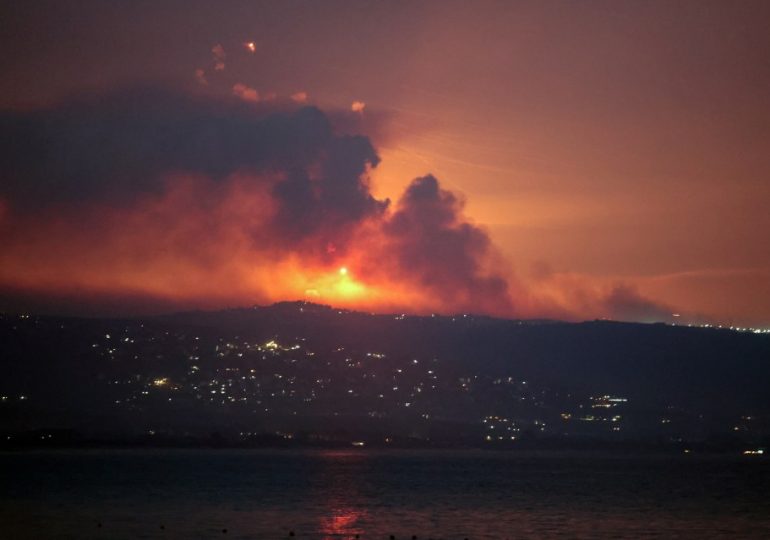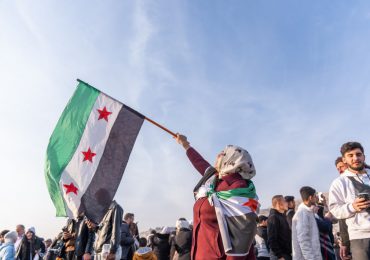HAMAS has claimed to have fired a rocket at Tel Aviv in response to Israel’s military operation inside Gaza.
The attack comes just hours after Hezbollah launched a barrage of missiles towards Israel amid fears of an all-out Middle East war.
ReutersPicture of an explosion in Lebanon last night as Israel launched airstrikes at Hezbollah targets[/caption]
Hamas previously fired multiple rockets at Israel as rocket sirens went off across Tel Aviv
The military group’s armed wing al-Qassam Brigades said it launched a “M90” rocket in response to “Israeli massacres against civilians”.
Chilling warning sirens were heard in Rishon Letsiyon – five miles from Tel Aviv – where the missile landed in an open area, the Israeli military said.
It is understood the missile was launched from Khan Younis – and did not do much damage to Israel.
It said: “Following the siren that sounded in Rishon LeTsiyon, one projectile was identified crossing from the southern Gaza Strip and falling in an open area in the area of Rishon LeTsiyon.”
This marks the second missile attack by Hamas on Israel since the October 7 massacre.
Back in May, the terror group launched a chilling barrage of rocket attacks on Israel forcing civilians to flee their homes.
It comes as Hezbollah launched a barrage of missiles towards Israel in a bid to avenge the killing of one of its founders and top commanders in an Israeli airstrike in Beirut last month.
For weeks Israel has been preparing to thwart a potential attack from the terror group and Iran – its puppet master – after it killed Ismail Haniyeh on Iranian soil.
The dangerous Iran-backed terror group aimed to fire thousands of rockets towards the north and central Tel Aviv, Israel claims, but was only able to launch a few hundred missiles after IDF strikes thwarted its plans.
Israel has engaged in tit-for-tat strikes with Hamas-allied Hezbollah for 10 months since war broke out in the Gaza Strip.
But yesterday’s attacks were the biggest escalation launched by the group since last year’s October 7 attacks from Gaza and sent tensions skyrocketing in Israel.
It threatens to trigger an all-out war which could draw in the United States, Iran and militant groups across the region.
Hezbollah’s leader Hassan Nasrallah swore the operation was only “phase one” of its master plan to avenge the assassination of its commander Fuad Shukr in Beirut last month.
Prime Minister Benjamin Netanyahu has vowed that Israel’s pre-emptive strikes are “not the end”.
He said: “Three weeks ago we eliminated his chief of staff, and today we foiled his attack plan.
“Nasrallah in Beirut [Hezbollah leader] and Khamenei in Tehran [supreme leader of Iran] should know that this is another step on the path to changing the situation in the north and returning our residents safely to their homes.
“And I repeat – this is not the end of the verse.”
Hamas’s October 7 attack on Israel resulted in the deaths of 1,199 people, most of them civilians.
Israel’s retaliatory military campaign has so far killed at least 40,405 people in Gaza, according to the Hamas-run territory’s health ministry.
Out of 251 hostages seized by Hamas militants in their attack, 105 remain in Gaza including 34 the Israeli military says are dead.
Recent tensions in the Middle East
By Ellie Doughty, Foreign News Reporter
After almost 10 months of the war in Gaza, tensions hit an all-new high following a series of deadly strikes and high-profile assassinations by Israel in late July and early August.
On Saturday, July 27, a rocket strike fired from southern Lebanon hit a football pitch in Golan Heights – a Druze village occupied by Israel – killing 12 young people including children.
Israel and the US both said Hezbollah, the largest of Iran’s terror proxy groups, operating out of Lebanon, was responsible for the deadly strike.
On Monday, July 28, the IDF dropped an airstrike on an area of Beirut, Lebanon’s capital, killing Hezbollah’s most senior military commander Fuad Shukr.
Less than two days later, at around 2am on Wednesday, July 30, Israel killed Hamas’ top political leader Ismail Haniyeh as he slept in Iran’s capital Tehran.
On the morning of Thursday, August 1 morning, the Israeli Defence Forces (IDF) announced that a strike on Khan Younis, southern Gaza, had killed Mohammed Deif on July 13.
Dief had worked as head of Hamas’ ruthless military wing, the al-Qassam brigades, since 2002.
It marked another major loss for Iran’s terror proxy groups in the region.
Early reports suggested Ismail Haniyeh was taken out in a precision strike when a rocket was fired from a drone outside his window and detonated inside the room.
Then an investigation by the New York Times suggested a bomb had been planted in his room at the military-run compound where he was staying and detonated remotely.
Unnamed Iranian officials also shared the explosive theory with The Telegraph, further confusing the murky details around Haniyeh’s death.
The Iranian Revolutionary Guard Corps (IRGC), concluded its investigation into the humiliating security breach on Saturday, August 1 and said he died after a “short-range projectile” was fired from outside the building.
Iran and its proxy groups; Hamas in Gaza, Hezbollah in Lebanon and the Houthis in Yemen all vowed to seek revenge on Israel over the assassination of Haniyeh.
Then, on the night of Saturday, August 3, Hezbollah fired some 30 rockets from Lebanon towards Galilee in northern Israel.
Tel Aviv’s impressive Iron Dome Defence system launched into action, destroying “most” of the missiles and no one was hurt.
But the UK, US and France have all urged their citizens to evacuate from Lebanon as fears of a wider war breaking out in the region continue to spiral.









